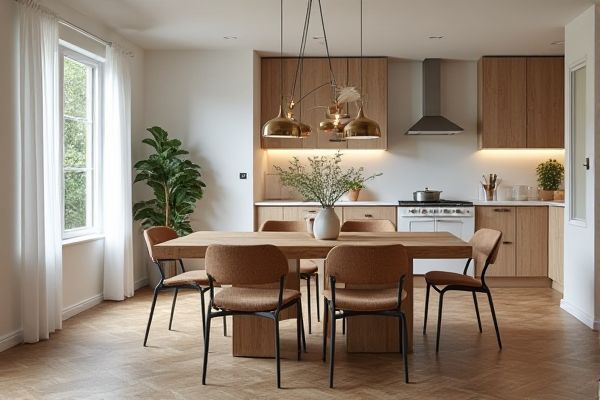
Dining tables typically offer a larger and more formal surface ideal for hosting meals, while kitchen tables are often smaller and designed for casual, everyday use in the heart of the home. Discover which option best suits Your space and lifestyle by reading the rest of the article.
Table of Comparison
| Feature | Dining Table | Kitchen Table |
|---|---|---|
| Primary Use | Formal meals and gatherings | Casual meals and food prep |
| Location | Dining room | Kitchen area |
| Size | Larger, seats 4-12 people | Smaller, seats 2-6 people |
| Material | Wood, glass, metal (elegant finishes) | Durable, easy-to-clean surfaces |
| Design | Stylish, formal design | Functional, minimal design |
| Usage Frequency | Less frequent, special occasions | Daily, routine use |
Introduction: Dining Table vs Kitchen Table
Dining tables typically offer larger surfaces designed to accommodate formal meals and multiple guests, while kitchen tables tend to be smaller and more casual, often used for quick meals or food preparation. Choosing between the two depends on your space, lifestyle, and entertaining needs, ensuring your home layout maximizes comfort and functionality. Your dining area benefits from a formal dining table to create an inviting atmosphere, whereas a kitchen table supports everyday convenience and accessibility.
Key Differences Between Dining and Kitchen Tables
Dining tables are typically larger, designed for formal meals and accommodating multiple guests, often made from high-quality materials to match dining room decor. Kitchen tables are smaller, more casual, and practical, intended for everyday use, quick meals, and multifunctional purposes like food prep or homework. Your choice depends on space, style preferences, and how you prioritize comfort vs. functionality in your eating area.
Purpose and Functionality
Dining tables primarily serve as the central spot for family meals and social gatherings, featuring larger dimensions to accommodate multiple people comfortably. Kitchen tables, often smaller and more versatile, function as casual eating areas and prep surfaces, blending food preparation with informal dining. The distinction lies in their design focus: dining tables emphasize formal seating and aesthetics, while kitchen tables prioritize convenience and everyday practicality.
Common Locations in the Home
Dining tables are typically placed in designated dining rooms or open-concept living areas designed for formal meals, offering ample space for family gatherings. Kitchen tables are often found directly within the kitchen or adjoining breakfast nooks, providing a convenient spot for casual dining and meal prep activities. Your choice depends on whether you prefer a dedicated space for meals or a more integrated, informal setting in the heart of your home.
Design and Style Variations
Dining tables often feature formal designs with elegant finishes and larger sizes to accommodate multiple guests, while kitchen tables tend to have casual, functional styles made for everyday use and smaller spaces. Materials for dining tables frequently include hardwoods like oak or walnut, offering durability and a polished look, whereas kitchen tables may incorporate lighter woods, metal, or laminate for easy cleaning and versatility. Your choice between these tables depends on the desired ambiance and practicality in your home's dining area.
Material Choices and Durability
Dining tables often feature solid hardwoods like oak, walnut, or maple, praised for their durability and timeless appeal, while kitchen tables frequently utilize more affordable materials such as laminate, MDF, or metal to withstand daily wear and moisture. Solid wood dining tables offer long-lasting strength and the ability to refinish surfaces, enhancing longevity, whereas kitchen tables prioritize easy maintenance and resistance to stains or scratches with coated or treated materials. Selecting the right material depends on balancing aesthetic preferences with expected usage and durability requirements in the dining or kitchen space.
Space and Seating Capacity
A dining table typically offers larger dimensions and higher seating capacity, designed to accommodate family meals and gatherings comfortably in dedicated dining rooms. Kitchen tables are generally smaller, suited for quick meals or casual dining in limited kitchen spaces, often seating four or fewer people. Optimizing space involves choosing a dining table for spacious areas with frequent entertaining needs, while kitchen tables maximize functionality in compact layouts.
Cost Comparison and Budget Considerations
Dining tables generally come at a higher cost than kitchen tables due to their larger size and more elaborate designs, with prices ranging from $200 to over $2,000 depending on materials and craftsmanship. Kitchen tables, often smaller and simpler, typically cost between $100 and $500, making them a more budget-friendly option for casual dining or smaller spaces. Your budget should account for not only the purchase price but also delivery, installation, and potential matching chairs, ensuring you select a table that offers the best value without compromising style or functionality.
Best Uses for Dining Tables
Dining tables are best suited for formal meals, family gatherings, and hosting dinner parties due to their larger size and elegant designs. They often accommodate multiple guests comfortably and serve as a focal point in dining rooms for both everyday use and special occasions. Dining tables typically support settings with fine china, serving dishes, and decorative centerpieces, enhancing the overall dining experience.
Best Uses for Kitchen Tables
Kitchen tables are ideal for casual meals, quick snacks, and family gatherings due to their smaller size and central location in the cooking area. They often serve as multi-functional spaces for meal prep, homework, and social interactions, making them perfect for busy households. Unlike formal dining tables, kitchen tables offer accessibility and practicality for daily use, especially in smaller kitchens or open-concept layouts.
 homyna.com
homyna.com